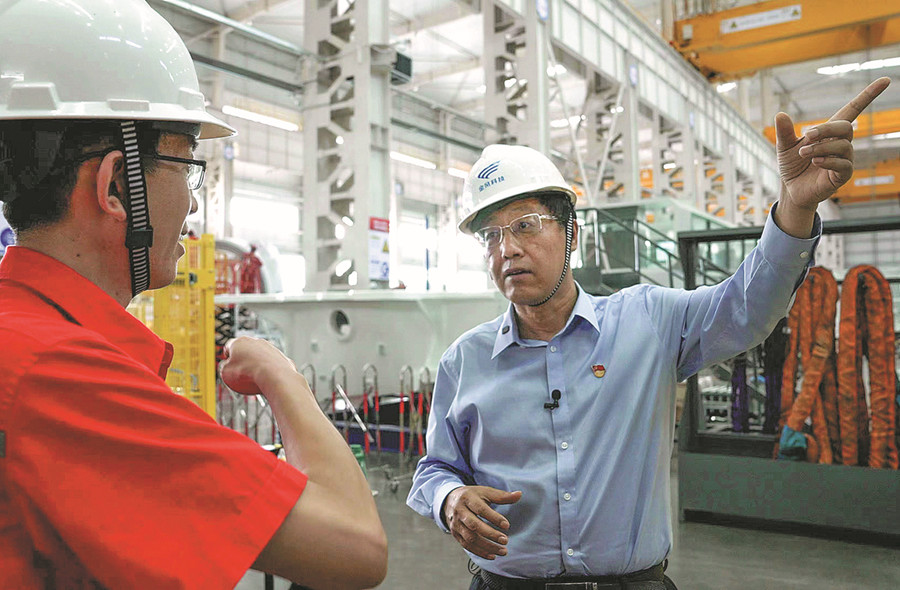Xinjiang harnesses wind power to build clean future

Wu Gang, chairman of Xinjiang Goldwind Science and Technology Co, talks with an engineer at a factory of the company in August. [Photo/Xinhua]
The fierce gales in Northwest China's Xinjiang Uygur autonomous region were once considered bad for business. Today, however, the gales have become big business itself, harvested by hundreds of giant turbines and transformed into electricity to power up the country.
Also thanks to the gales, Dabancheng of Urumqi, capital of the region, has turned itself from an arid plain into a pioneer in the Chinese wind industry that has been leading the world for years.
Wu Gang, chairman of Xinjiang Goldwind Science and Technology Co, also a pioneer in the Chinese wind industry who has been elected as a delegate to the 20th National Congress of the Communist Party of China, helped make that happen.
Wu quitted his job as a teacher back in the late 1980s to help set up Dabancheng wind farm, braving the cold and ferocious gales to measure the wind at Dabancheng.
Captivated by the idea that energy could be produced by wind, Wu joined Xinjiang Wind Energy, one of China's pioneering wind companies, in 1987. Together, Wu and their team persisted in their vision of wind power and built Dabancheng wind farm.
Wu and a group of colleagues founded Goldwind in 1998. The goal was "establishing Xinjiang as the birthplace of China's domestic wind energy industry".
Fast-forward to 2013, Wu's Goldwind was China's largest manufacturer of wind turbines and the world's second largest, with more than 10 percent of the global market share. It had installed more than 14,000 turbines and had a presence on every continent except Antarctica.
Today, Goldwind ranks second only to Denmark's Vestas among global wind turbine makers, with its business covering 38 countries and regions across the world.
Wu attributed the success and rapid rise of China's wind power industry to strong engineering skills, and an ability both to acquire technology from other companies and develop its own technology.
The rapid growth of the wind industry at home and abroad has provided a critical boost, together with the backing of Chinese national policies, he said.
Thanks to the joint efforts of Goldwind and its peers, China's wind turbine output now accounts for two-thirds of the world's total due to its large-scale production and technological breakthroughs.
The turbine industry used to be dominated by foreign manufacturers, including Vestas of Denmark, Gamesa of Spain and GE of the United States. However, according to the Global Wind Energy Council's annual supply-side data, Goldwind is the second-largest global turbine supplier with 11.8 percent, after only Vestas with 17.7 percent of new installations in 2021.
Out of the global top 15 wind turbine suppliers last year, 10 come from China, and two Chinese companies made the top 5, it said.
An analyst said China has risen from being a novice to a pioneer in the wind power industry, with huge progress in localizing wind power technology.
Wind power has developed in leaps and bounds in China over recent years, as it plays a crucial role in fulfilling the Chinese government's pledge to achieve peak carbon dioxide emissions by 2030 and carbon neutrality by 2060, said Wei Hanyang, a power market analyst at research firm BloombergNEF.
Copyright © The National Committee of the Chinese People's Political Consultative Conference.
All rights reserved. Presented by China Daily.
京ICP备08100501号-1

